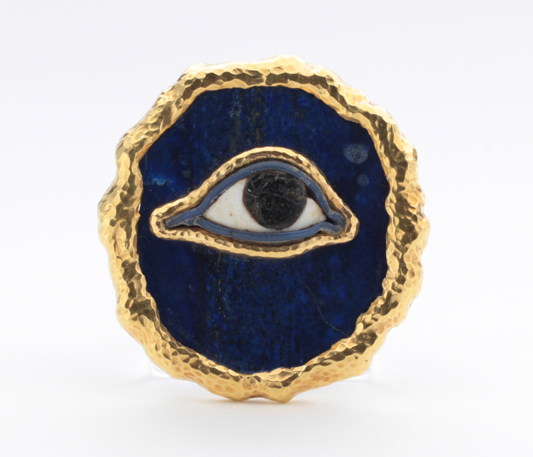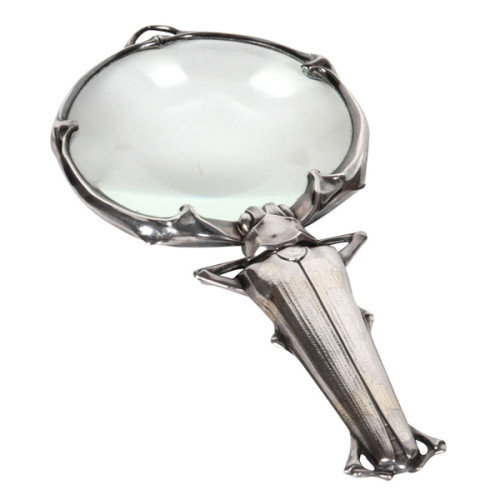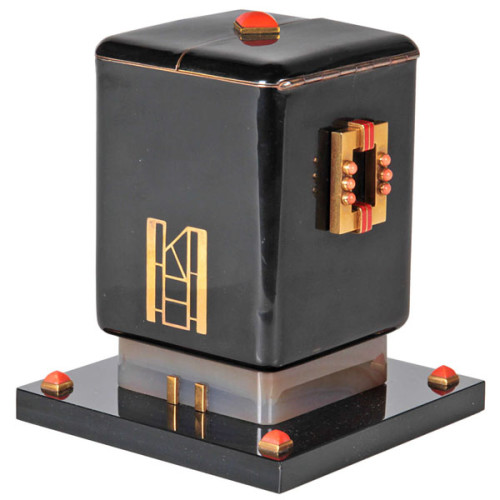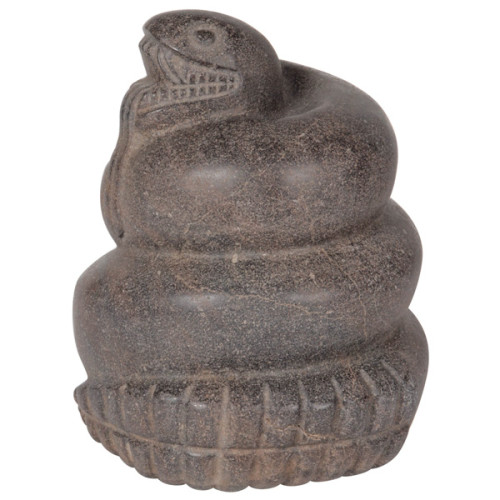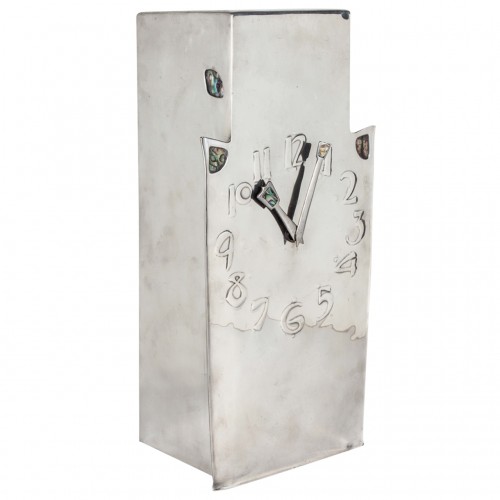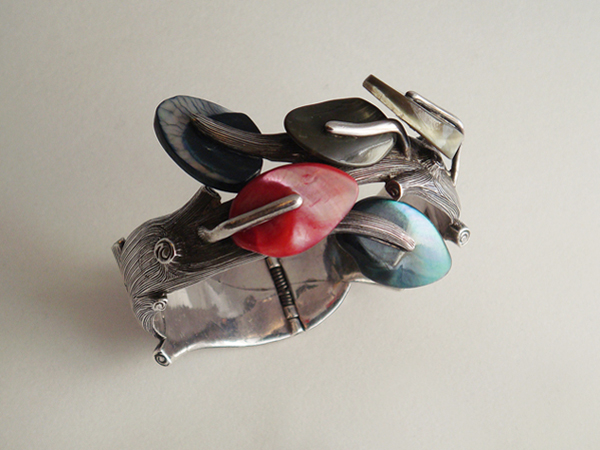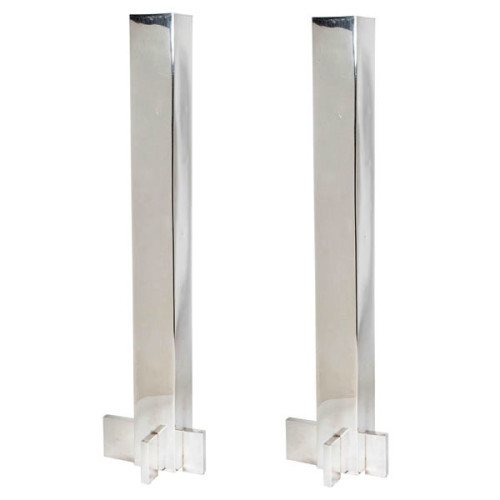Important
-
Cartier, Important jabot brooch, fan shaped with round and baguette shaped diamonds (Indian Royal Briolette diamond, 6.11 carats, G.I.A. certificate) set in platinum, original leather box, signed, c. 1925
-
David Webb, Important “Eye of Horus” brooch, ancient Egyptian eye relic, lapis set in 18K gold, signed, c. 1960’s
-
Paul Flato, signed, Important “Elizabeth Arden” Trompe L’oeil black suede and red leather “Wrapped Package” Necessaire containing silver, gold and enamel envelopes, postmarked New York, Dec. 31st, 1938
PAUL FLATO (1900-1999)
Paul Flato, signed, Important Necessaire in the shape of a Trompe L’oeil black suede and red leather “Wrapped Package” containing silver, gold and enamel “Envelopes / Packages” Made Expressly for Elizabeth Arden, postmarked and dated New York, Dec. 31st, 1938
Sterling silver and 14K gold details with black and various colored champlevé enamels as trompe l’oeil mailed package/envelopes addressed to Elizabeth Arden and postmarked New York Dec. 31st, 1938 in the forms of a cigarette case, powder compact, watch and lipstick case with an additional red leather change purse and comb all within a black suede with red leather interior “wrapped package” envelope case detailed with red enamel seals and gold twisted cording
Marks: FLATO (4x), Sterling, 14K, Pat. Pending (2x), Elizabeth Arden, New York
Dec. 31st, 1938 (script signature and date in champlevé enamel, four pieces)
Provenance: Elizabeth Arden (born Florence Nightingale Graham 1884-1966), Private Collection London, Private Collection New York
For more information about Flato and his close friendship with Elizabeth Arden see: Paul Flato Jeweler to the Stars, Elizabeth Irvine Bray (Antique Collectors’ Club Ltd. Woodbridge, Suffolk UK, 2010) pp. 40,79,88 and 142 (for related gold stamped and addressed envelope cases)
Black suede and red leather case: H: 4 ¼”x W: 7 ¼” x D: 2”
Paul Flato was one of the most successful jewelry designers of the 1930’s and 40’s and in his heyday was as famous as Tiffany & Co. and Harry Winston! Flato made custom jewelry for Doris Duke, Millicent Rogers and Linda and Cole Porter. However, he was particularly well known and liked in Hollywood and was the favored jeweler to stars such as Rita Hayworth, Katherine Hepburn and Greta Garbo who all wore his jewels both on and off the movie sets. In fact, he designed the jewelry for six films including “Holiday” starring Cary Grant and Katherine Hepburn in 1938. Flato designed jewels for and was a close friend of the legendary cosmetics tycoon, Elizabeth Arden and together they shared a particular bond and love of promotion, politics and racehorses.
“Around 1940, Flato had a very large pink diamond set in a ring, in a very creative and ingenious maneuver, he contacted Elizabeth Arden’s public relations department. In a memo entitled “Arden Plan for Publicity on the Pink Diamond,” Flato presented ideas for a dual promotion of Arden and Flato: Mr. Flato has available a large pink diamond, weight about 25-35 carats. He has shown it along with other jewelry at fashion shows but has never promoted it. The ring is still available. Elizabeth Arden, his close personal friend and a good customer, has been studying jewels in order to develop new nail-polish and make-up. I was told that she was creating a line of make-up linked to colored stones…. We took up with Miss Wobber her publicity chief the idea of naming her natural or rose nail-polish “PINK DIAMOND” and we would co-operate on publicity… Miss Arden likes the idea so well she wants to do a new nail-polish and lipstick called “PINK DIAMOND.”
ELIZABETH ARDEN (1884-1966)
Florence Nightingale Graham, who adopted the business name Elizabeth Arden was a Canadian born American entrepreneur who built an enormously successful cosmetics empire in the US and at the peak of her career was one of the wealthiest women in the world! Early in her life, she briefly worked as a bookkeeper for the E.R. Squibb Pharmaceuticals Company and began spending many hours in their laboratory learning about skincare. She went on to work as a beauty culturist and in 1912 traveled to France to learn beauty and facial massage techniques. Arden revolutionized cosmetics, bringing a scientific approach to her make-up and skin-care formulations. She innovatively brought modern eye makeup to North America, introduced the concept of the “makeover” in her salons where she created foundations that matched a person’s skin tone creating a “total look” and was the first to make a cosmetics commercial shown in movie houses. In the early 1940’s, she also started a fashion business with Charles James and Oscar de la Renta on staff. During WWII, Arden addressed the needs of women entering the workforce and created a lipstick called Montezuma Red for the women in the armed forces that would match the red on their uniforms. Elizabeth Arden began expanding her international salon operations as early as 1915 and eventually opened salons in virtually all the major cities in the world. By the end of the 1930’s, it was said that “There are only three American names that are known in every single corner of the globe: Singer sewing machines, Coca Cola, and Elizabeth Arden.” A fact proved by Heinrich Harrer in his book “Seven Years in Tibet,” where he stated that it’s possible to buy Arden products —- even in Tibet. From the 1930’s through the 1960’s, Elizabeth Arden was considered the most upscale cosmetic brand with celebrated clientele that included Queen Elizabeth, Marlene Dietrich, Joan Crawford, Wallis Simpson, Jacqueline Kennedy and Marilyn Monroe.
-
Important Lucien Gaillard “Staghorn beetle” silver and gold inlay magnifying glass, signed c. 1900
Silver hand finished and repoussed in the form of a staghorn beetle with horns encircling the round magnifying glass, gold details
Signed: L. GAILLARD (engraved) on lower right leg, head of Minerva (950/1000 pure silver)
The staghorn beetle was a favorite form for Gaillard and the inspiration for many examples of his work including jewelry, vases and this magnifying glass. A variant model in cast bronze can be seen in the collection of the Musee d’Orsay in Paris.
-
Maison Ostertag Important French Art Deco Jewel Mounted Covered Box c.1925
MAISON OSTERTAG (Place Vendome, Paris) 1920’s and 30’s
ARNOLD OSTERTAG (Jeweler / Designer)
VERGER FRERES (maker)Art Deco jewel mounted mechanical covered box c. 1925
Of rectangular stepped form, the black enamel box hinged and accented at the top with a gold bezel mounted sugar loaf shaped coral; spring loaded to pull down and reveal a cinnabar red enamel interior, the exterior with gold champlevé set highly stylized geometric initials and further ornamented with geometric square cut out gold applied handles embellished with salmon coral beads and red enamel bands, all resting on a recessed agate base and conforming black onyx base punctuated with a gold bezel mounted sugar loaf shaped coral on each corner.
Marks: Ostertag (on a gold plaque inset into the underside of the onyx base)
H: 4″ x W: 3 1/2″ x D: 3 1/2″
Arnold Ostertag was a Swiss-born jeweler who became a dominant force in the creation of fine jewels and objects in Paris during the 1920s and 30s. After studying dentistry in Chicago, Ostertag embarked on a world tour and, while traveling through India, became fascinated by jewels. He later settled in Paris and opened a very successful salon on the Place Vendome. In design and quality, Ostertag’s jewels, which frequently featured Indian themes, rivaled the production of many of the most famous Parisian jewelry houses. In fact, the renowned clockmaker George Verger/Verger Freres, produced wonderful clocks and mechanical objects for Ostertag, as well as for many other world renowned jewelers and likely masterminded the mechanism of the Art Deco box above. In addition to making pieces for Ostertag, Maison Verger made pieces for Cartier, LaCloche, Marzo, Boucheron, Hermes, Van Cleef & Arpels, Chaumet, Mauboussin, etc. Arnold Ostertag was popular on the international front and made many trips to America spending time in both New York, as well as Los Angeles where he befriended many Hollywood stars. He also received commissions during his trips to make exquisite custom jewelry and precious jeweled objects such as this fine Art Deco box.
-
Asprey & Co., Important Cardinal Sculpture gem set with natural rubies, 18K gold and amethyst quartz, signed,1980
ASPREY & CO. LTD. (founded 1781) London, UK
Important Natural Ruby Gem Set 18K Gold Cardinal Bird Sculpture 1980
Finely chased and chiseled 18K yellow and white gold realistically rendered sculpture of a Cardinal bird set with
85+ carats (approx.) of natural gem quality oval and round cut Burmese rubies (GIA certificate) further heightened with enamel eyes and blackened gold face plumage details, the 18K gold and natural ruby cardinal sets atop a natural Amethyst crystal “mountain rock” with a tooled and gilt (script mark) on the leather under-pad.Marks: A & Co. (in a quatrefoil), Crown mark, 750 (gold standard mark) Lion’s head (London assay mark) “F” date mark for 1980, tooled and gilt Asprey (script mark) on the leather under-pad
Provenance: Privately commissioned by the Sultan of Brunei’s younger brother, Prince Jefri Bolkiah who also later became the owner of Asprey & Co in the 1995. This rare sculptural 18K gold and natural ruby Cardinal was handmade by the finest jewelers and work masters in the workshop of the London Asprey & Co. located above the flagship store at 167 New Bond Street.
H: 3 ¾” x L: 5 3/4” x W: 1 ½”(Cardinal only)
H: 6” x W: 6 ¾” x D: 5 ¾” (with Cardinal atop natural Amethyst crystal rock)As one might guess, a large part of the animal symbolism of the cardinal comes from the brilliant red color of the males. In fact, its name is derived from the royal red vestments worn by Catholic cardinals. This shock of red, especially against the stark backdrop of winter snow, is a magnificent sight. The male cardinal reminds us passion, warmth and vibrancy is available to us – even under the cloak of Winter’s grey clouds. Interestingly, the more bold and bright his color is, the more successful the cardinal will be at prolonging his lineage. Dull colored male cardinals are less likely to mate successfully than bright colored ones. True to the fire of his color, the crimson cardinal has got some major spunk. He will aggressively defend his territory, and fight attackers with ferocity. Indeed, they have been known to fight ghost males (their reflections) in mirrors for hours on end. Both male and female give us glorious songs. Along with peeps and pips and warbles, the tuned ear can also hear “cheer, cheer, cheer!” Very appropriate to the animal symbolism of cardinals, because they are a delight to both eyes and ears. The cardinal makes a fantastic animal totem. It reminds us to hold ourselves with pride, not ego pride but rather the cardinal asks us to stand a little taller, be a bit more regal and step into our natural confidence as if we were born to lead with grace and nobility. Those who attract the cardinal as their totem are naturally energetic, love life, and happily help others where and when they can!
-
Aztec AD 1325-1475 Important stone carved sculpture of a coiled serpent
AZTEC AD 1325-1475 Mexico.
Important stone carved sculpture of a coiled serpent, AD 1325-1475 Mexico.
***Two scientific authentication reports are available with this sculpture.
H: 10″ x D: 8″
The serpent played a very important role in Aztec religion and was represented in a variety of forms. The majority of the serpents represented in Aztec sculpture are rattlesnakes.
Mexican mythology indicates the snake is a symbol of veneration, worship and honor. Often a symbol of great power, resurrection and rebirth, the snake continues to be a powerful emblem of renewal and transition.
Further, the snake is recognized as a symbol of humanity as a whole. Interestingly, the Mexican perspective provides hope for mankind to aspire to great heights as it correlates the shedding of the serpent’s skin to man’s ability to change his own circumstances and overcome adversity.The Aztecs build an impressive empire in the valley of Mexico. This thriving area, known as Tenochitlan, was the cultural, religious and trading center of Mesoamerica. Aztecs were the Native American people who dominated northern Mexico at the time of the Spanish conquest led by Hernan Cortez in the early 16th century. According to their own legends, they originated from a place called Aztlan, somewhere in north or northwest Mexico. At that time the Aztecs (who referred to themselves as the Mexica, or Tenochca) were a small, nomadic, Nahuatl-speaking aggregation of tribal peoples living on the margins of civilized Mesoamerica. Sometime in the 12th century they embarked on a period of wandering and in the 13th century settled in the central basin of México. Continually dislodged by the small city-states that fought one another in shifting alliances, the Aztecs finally found refuge on small islands in Lake Texcoco where, in 1325, they founded the town of Tenochtitlan (modern-day Mexico City). The term Aztec, originally associated with the migrant Mexica, is today a collective term, applied to all the peoples linked by trade, custom, religion, and language to these founders. Warriors and pragmatic builders, the Aztecs created an empire during the 15th century that was surpassed in size in the Americas only by that of the Incas in Peru. As early texts and modern archaeology continue to reveal, beyond their conquests and many of their religious practices, the Aztecs had many positive achievements: the formation of a highly specialized and stratified society and an imperial administration, the expansion of a trading network as well as a tribute system, the development and maintenance of a sophisticated agricultural economy (which was carefully adjusted to the land) and the cultivation of an intellectual and religious outlook that held society to be an integral part of the cosmos.
-
Archibald Knox / Liberty & Co. Important and Rare Tudric Clock 1902
ARCHIBALD KNOX (1864-1933) UK
LIBERTY & CO. LondonExtremely rare and important grand clock by Archibald Knox for Liberty & Co. This is the largest of all of the Tudric models designed and is inset with abalone shell on the sides, the front corners and on the hands of the clock.
Marks: TUDRIC, 098
Illustrated: The Designs of Archibald Knox for Liberty & Co., A..J. Tilbrook (London: Ornament Press Ltd., 1976) pg. 88; The Liberty Style, (Japan: Hida Takayama Museum of Arts, 1999) fig. 168, p 114; Archibald Knox, ed. by Stephen A. Martin (London: Academy Editions, 1995) p. 88.
H: 15″ x W: 7″ x D: 5″
***This is the largest clock designed by Archibald Knox for
Liberty & Co. and one of only three models known. -
Gorham T.B. Starr Important Sterling “Macy” Renaissance Revival Pitcher 1893
GORHAM MFG. CO SILVERSMITHS Providence, RI
THEODORE B. STARR RetailerRenaissance Revival pitcher 1893
A highly important Gorham sterling pitcher chased with mythological faces, putti and various scrolling foliate patterns, the handle in the form of Pan with four sphinx figures supporting the base, all with elaborate and exquisite hand chasing and repousse throughout. Extremely fine original condition with original gilded interior.
Marks: Lion, Anchor, G (Gorham silver touch marks), EX. (Exhibition), Theodore B. Starr, 6 pint, Sterling, 1805, double circle touch mark (date mark for 1893)
Provenance: Private Collection, New York; Private Collection Florida from 1984 to 2009; directly descended in the family of Thomas H. Macy (founder of Nantucket) prior to 1984
Weight: 74 troy oz.
H: 13″ x W: 10″ x D: 7″
-
Salvatore Meli Important large scale Italian Sculpture / Ewer 1952
SALVATORE MELI (b. 1929) Italy
Important Sculpture / Ewer 1952
Glazed terra cotta, brown and dark green with white scraffito decoration, original stepped and angular wood base.
Signed: Meli 1952 Roma
For more info on Meli see: Design 1935-1965, What Modern was, ed. Martin Eidelberg (New York: Harry Abrams, 1991) p. 237.
Salvatore Meli belongs to that initial group of artists, including Guido Gambone and Lucio Fontana among others, who elevated Italian ceramics to a fine art during the post-war period. Meli conceived this vessel, first on paper, then by laboriously constructing the body in clay, coil by coil, to achieve the richly textured and dynamic form; the incised and painted decoration is in concert with the organic shape. The massive scale of this work defies function as a ewer but was created as a sculptural object. The original wooden base recalls Italian futurist sculpture forms of the early twentieth century.
H (with base): 23 1/2” x W: 13” x D: 9.5”
H (without base): 19 1/8”Price: $27,500
-
Antonio Pineda Important “Exotic Leaf & Tree” bracelet, sterling set with carved shell, signed c. 1940’s
-
Antonio Pineda Important Sterling Architectural Candlesticks c.1955-60
ANTONIO PIÑEDA (1919-2009) Taxco, Mexico
Important Architectural Candlesticks c.1955-60
Handwrought sterling silver in exaggerated tall rectangular forms with various size rectangular geometric elements attached as the base supports, 100 troy ounces total weight
Marks: Antonio Taxco (crown mark), 925, Mexican Eagle silver standard mark, Mexican circular mark, Hecho en Mexico
Provenance: Antonio Pineda, 1990
***According to Antonio Pineda, these are one pair of only three pair made!
H: 20 ½” x W: 5” x D: 4”
-
Antonio Pineda Important “Triangle and Diamond” pitcher, sterling, signed, Exhibited: Triennale di Milano, Italy, 1960
ANTONIO PIÑEDA (1919-2009) Taxco, Mexico
Exhibition Pitcher c.1959-60
Handwrought sterling silver in an overall triangular form with a diamond opening and a double splayed form and contoured handle, 30 troy ounces total weight
Marks: Antonio Taxco (large crown mark) Sterling Silver, 930, Mexican Eagle silver standard mark
Exhibited at the Triennale di Milano, Italy, 1960
Provenance: Antonio Pineda, 1990
Illustrated: Triennale di Milano, Argentería di Antonio Pineda,
Exhibition Catalogue (Milan, 1960).H: 6 5/8” x L: 9 ½” x D: 5 ¾”


